Introduction to Elasticity/Vectors
< Introduction to ElasticityVectors in Mechanics
Vector notation is ubiquitous in the modern literature on solid mechanics, fluid mechanics, biomechanics, nonlinear finite elements and a host of other subjects in mechanics. A student has to be familiar with the notation in order to be able to read the literature. In this section we introduce the notation that is used, common operations in vector algebra, and some ideas from vector calculus.
Vectors
A vector is an object that has certain properties. What are these properties? We usually say that these properties are:
- a vector has a magnitude (or length)
- a vector has a direction.
To make the definition of the vector object more precise we may also say that vectors are objects that satisfy the properties of a vector space.
The standard notation for a vector is lower case bold type (for example  ).
).
In Figure 1(a) you can see a vector  in red. This vector can be represented in component form with respect to the basis (
in red. This vector can be represented in component form with respect to the basis ( ) as
) as
where  and
and  are orthonormal unit vectors. Recall that unit vectors are vectors of length 1. These vectors are also called basis vectors.
are orthonormal unit vectors. Recall that unit vectors are vectors of length 1. These vectors are also called basis vectors.
You could also represent the same vector  in terms of another set of basis vectors (
in terms of another set of basis vectors ( ) as shown in Figure 1(b). In that case, the components of the vector are
) as shown in Figure 1(b). In that case, the components of the vector are  and we can write
and we can write
Note that the basis vectors  and
and  do not necessarily have to be unit vectors. All we need is that they be linearly independent, that is, it should not be possible for us to represent one solely in terms of the others.
do not necessarily have to be unit vectors. All we need is that they be linearly independent, that is, it should not be possible for us to represent one solely in terms of the others.
In three dimensions, using an orthonormal basis, we can write the vector  as
as
where  is perpendicular to both
is perpendicular to both  and
and  . This is the usual basis in which we express arbitrary vectors.
. This is the usual basis in which we express arbitrary vectors.
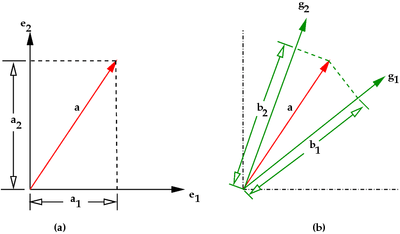 Figure 1: A vector and its basis. |
Vector algebra
Some vector operations are shown in Figure 2.
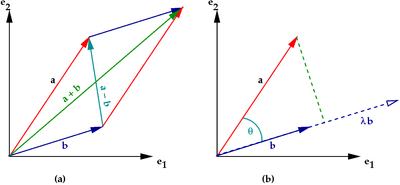 Figure 2: Vector operations. |
Addition and subtraction
If  and
and  are vectors, then the sum
are vectors, then the sum  is also a vector (see Figure 2(a)).
is also a vector (see Figure 2(a)).
The two vectors can also be subtracted from one another to give another vector  .
.
Multiplication by a scalar
Multiplication of a vector  by a scalar
by a scalar  has the effect of stretching or shrinking the vector (see Figure 2(b)).
has the effect of stretching or shrinking the vector (see Figure 2(b)).
You can form a unit vector  that is parallel to
that is parallel to  by dividing by the length of the vector
by dividing by the length of the vector  . Thus,
. Thus,
Scalar product of two vectors
The scalar product or inner product or dot product of two vectors is defined as
where  is the angle between the two vectors (see Figure 2(b)).
is the angle between the two vectors (see Figure 2(b)).
If  and
and  are perpendicular to each other,
are perpendicular to each other,  and
and  . Therefore,
. Therefore,  .
.
The dot product therefore has the geometric interpretation as the length of the projection of  onto the unit vector
onto the unit vector  when the two vectors are placed so that they start from the same point.
when the two vectors are placed so that they start from the same point.
The scalar product leads to a scalar quantity and can also be written in component form (with respect to a given basis) as
If the vector is  dimensional, the dot product is written as
dimensional, the dot product is written as
Using the Einstein summation convention, we can also write the scalar product as
Also notice that the following also hold for the scalar product
 (commutative law).
(commutative law). (distributive law).
(distributive law).
Vector product of two vectors
The vector product (or cross product) of two vectors  and
and  is another vector
is another vector  defined as
defined as
where  is the angle between
is the angle between  and
and  , and
, and  is a unit vector perpendicular to the plane containing
is a unit vector perpendicular to the plane containing  and
and  in the right-handed sense (see Figure 3 for a geometric interpretation)
in the right-handed sense (see Figure 3 for a geometric interpretation)
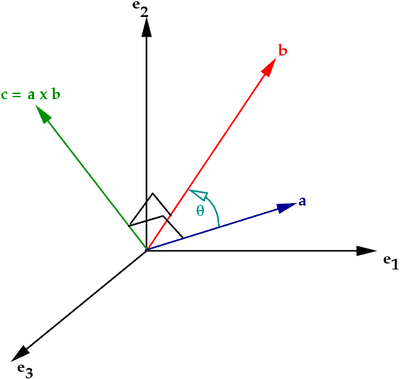 Figure 3: Vector product of two vectors. |
In terms of the orthonormal basis  , the cross product can be written in the form of a determinant
, the cross product can be written in the form of a determinant
In index notation, the cross product can be written as
where  is the Levi-Civita symbol (also called the permutation symbol, alternating tensor).
is the Levi-Civita symbol (also called the permutation symbol, alternating tensor).
Identities from vector algebra
Some useful vector identities are given below.
-
 .
. -
 .
. -
 .
. -
 .
. -
 .
. -
 .
. -
 .
.
Vector calculus
So far we have dealt with constant vectors. It also helps if the vectors are allowed to vary in space. Then we can define derivatives and integrals and deal with vector fields. Some basic ideas of vector calculus are discussed below.
Derivative of a vector valued function
Let  be a vector function that can be represented as
be a vector function that can be represented as
where  is a scalar.
is a scalar.
Then the derivative of  with respect to
with respect to  is
is
If  and
and  are two vector functions, then from the chain rule we get
are two vector functions, then from the chain rule we get
Scalar and vector fields
Let  be the position vector of any point in space. Suppose that
there is a scalar function (
be the position vector of any point in space. Suppose that
there is a scalar function ( ) that assigns a value to each point in space. Then
) that assigns a value to each point in space. Then
represents a scalar field. An example of a scalar field is the temperature. See Figure4(a).
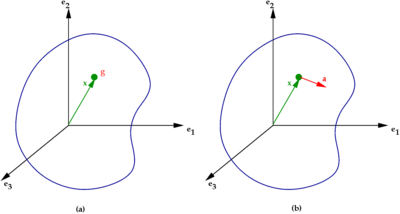 Figure 4: Scalar and vector fields. |
If there is a vector function ( ) that assigns a vector to each point in space, then
) that assigns a vector to each point in space, then
represents a vector field. An example is the displacement field. See Figure 4(b).
Gradient of a scalar field
Let  be a scalar function. Assume that the partial derivatives of the function are continuous in some region of space. If the point
be a scalar function. Assume that the partial derivatives of the function are continuous in some region of space. If the point  has coordinates (
has coordinates ( ) with respect to the basis (
) with respect to the basis ( ), the gradient of
), the gradient of  is defined as
is defined as
In index notation,
The gradient is obviously a vector and has a direction. We can think of the gradient at a point being the vector perpendicular to the level contour at that point.
It is often useful to think of the symbol  as an operator of the form
as an operator of the form
Divergence of a vector field
If we form a scalar product of a vector field  with the
with the  operator, we get a scalar quantity called the
divergence of the vector field. Thus,
operator, we get a scalar quantity called the
divergence of the vector field. Thus,
In index notation,
If  , then
, then  is called a divergence-free field.
is called a divergence-free field.
The physical significance of the divergence of a vector field is the rate at which some density exits a given region of space. In the absence of the creation or destruction of matter, the density within a region of space can change only by having it flow into or out of the region.
Curl of a vector field
The curl of a vector field  is a vector defined as
is a vector defined as
The physical significance of the curl of a vector field is the amount of rotation or angular momentum of the contents of a region of space.
Laplacian of a scalar or vector field
The Laplacian of a scalar field  is a scalar defined as
is a scalar defined as
The Laplacian of a vector field  is a vector defined as
is a vector defined as
Green-Gauss divergence theorem
Let  be a continuous and differentiable vector field on a body
be a continuous and differentiable vector field on a body  with boundary
with boundary  . The divergence theorem states that
. The divergence theorem states that
where  is the outward unit normal to the surface (see Figure 5).
is the outward unit normal to the surface (see Figure 5).
In index notation,
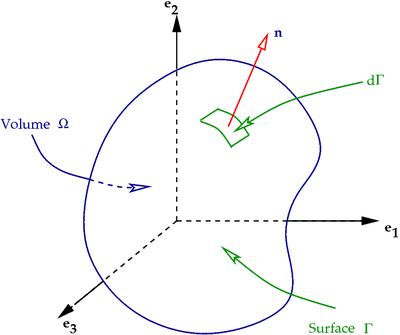 Figure 5: Volume for application of the divergence theorem. |
Identities in vector calculus
Some frequently used identities from vector calculus are listed below.
 .
. .
. .
. .
. .
.













![\begin{align}
\cfrac{d({\mathbf{a}}\bullet{\mathbf{b}})}{dx} & =
{\mathbf{a}}\bullet{\cfrac{d\mathbf{b}}{dx}} + {\cfrac{d\mathbf{a}}{dx}}\bullet{\mathbf{b}} \\
\cfrac{d({\mathbf{a}}\times{\mathbf{b}})}{dx} & =
{\mathbf{a}}\times{\cfrac{d\mathbf{b}}{dx}} + {\cfrac{d\mathbf{a}}{dx}}\times{\mathbf{b}} \\
\cfrac{d[{\mathbf{a}}\bullet{({\mathbf{b}}\times{\mathbf{c}})}]}{dx} & =
{\cfrac{d\mathbf{a}}{dx}}\bullet{({\mathbf{b}}\times{\mathbf{c}})} +
{\mathbf{a}}\bullet{\left({\cfrac{d\mathbf{b}}{dx}}\times{\mathbf{c}}\right)} +
{\mathbf{a}}\bullet{\left({\mathbf{b}}\times{\cfrac{d\mathbf{c}}{dx}}\right)}
\end{align}](../I/m/038accc744b1de52cab75a4a2f1c5e91.png)











